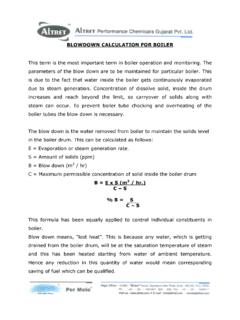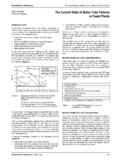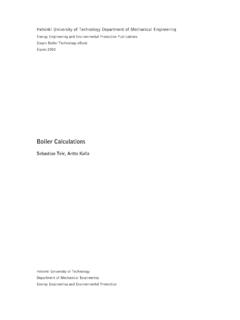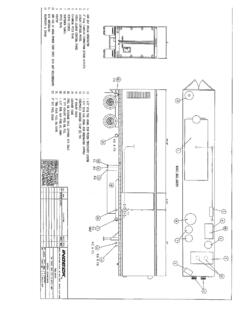Transcription of EPA Emissions Rules for Boilers - aeeohio.com
1 EPA Emissions Rules for Boilers The EPA has published two new Rules for Boilers in an effort to reduce Emissions of air pollutants. The two Rules are the Major Source Rule (also known as the boiler MACT or BMACT). and the Area Source Rule. The information, forms, and tools necessary for compliance are included in this package. Contents Page Overview 2. Step 1 3. Step 2 4. Step 3 5. Frequently Asked Questions 6. Definitions 10. EPA Regional Offices 12. Major Source Instructions / Initial Notification Forms 14. Area Source Instructions / Initial Notification Forms 21. Compliance Dates Summary 29. Emissions Limits By boiler 31. Decision Tree 32. Exclusions To The Area Source Rule 33. 1. EPA Emissions Rules for Boilers On March 21, 2011, the Environmental Protection Agency (EPA) published three Rules regarding air Emissions standards in the Federal Register. Two of the three Rules pertain to Boilers and are specifically designed to reduce Emissions of air pollutants.
2 The two Rules are: Major Source ( boiler MACT) Rule: Rules to reduce boiler and process heater Emissions at large sources of air toxics Area Source Rule: Rules to reduce boiler Emissions at small sources of air toxics The EPA is reconsidering parts of the Major Source and Area Source Rules . While it is carrying out the formal reconsideration process, the EPA announced in May 2011 that it would delay the implementation of the Major Source Rule (also known as boiler MACT or BMACT) until further notice. However, the compliance requirements of the Area Source Rule, which include the majority of Boilers in the United States, are in effect while the EPA is reconsidering this rule. Affected boiler owners must take immediate action to begin compliance. The first step is sending an initial notification form to the EPA. Although the Rules for Major Source facilities are not yet in effect, Industrial Combustion recommends that Major Source facilities send in notification of their status as a Major Source.
3 Examples of the types of requirements under these two new Rules include: boiler tune-ups, Emissions limit requirements, one-time energy assessments, and monthly fuel monitoring. To determine which records and reports are required for your boiler , consult the decision tree on page 32. For a summary of compliance dates specific to your boiler , see page 29. For a summary of specific Emissions limits by boiler type, see page 31. To determine rule applicability and compliance actions required, complete the following three steps: Step 1: Determine if your facility is an Area Source or Major Source. Step 2: Determine boiler (s) subcategory for: a) Fuels Combusted; b) New vs. Existing Source; c) Size of boiler . Step 3: Submit Initial Notification of Applicability and Determine Compliance Requirements. Do not delay in completing the above three steps. Several reports are required to validate compliance with the new Rules .
4 The first report to be submitted was an Initial Notification of Applicability. It was due September 17, 2011 if startup was before May 20, 2011. If startup was on or after May 20, 2011, the notification was due September 17, 2011, or within 120 days 2. after startup for Area Source facilities, or within 15 days after startup for Major Source facilities. If you missed the notification deadline, send in your form as soon as possible. We will continue to update information as it becomes available and upload the forms necessary for compliance. If you would like to receive notification when we post updates, please register your e-mail address below. Step 1. Determine if your facility is an Area Source or Major Source. There are two Rules , the Major Source Rule (also known as the boiler MACT or BMACT) and the Area Source Rule. The first step is to determine if your facility is subject to the Major Source Rule (pertaining to Boilers and process heaters at large sources of air toxics) or the Area Source Rule (pertaining to Boilers at small sources of air toxics).
5 A Major Source facility emits 10 or more tons per year of any single air toxic or 25 tons or more per year of any combination of air toxics. A comprehensive list of the regulated air toxics can be found on the EPA website at The majority of Major Source Boilers and process heaters are generally located at very large industrial facilities, such as refineries, chemical and large manufacturing plants, and large institutional facilities such as universities. Any facility that is not a Major Source is classified as an Area Source. Most Boilers covered by the Area Source Rule are located at commercial and institutional facilities, with a smaller number in the industrial sector. Commercial Boilers include those found in stores/malls, laundries, apartments, restaurants, and hotels/motels. Institutional Boilers are found in many locations, including medical centers (hospitals, clinics, nursing homes), educational and religious facilities (schools, churches), amusement parks, and municipal buildings (courthouses, prisons).
6 Many manufacturing facilities are also Area Sources. To calculate how to estimate Emissions from your source to determine if you are a Major Source or Area Source facility, consult the EPA Emission Inventory Improvement Program document, Preferred and Alternative Methods for Estimating Air Emissions from Boilers at Sections 4 and 5 show Emissions calculation methods. After determining which rule is applicable to your facility: Major Sources: Skip to Step 3: Submit Initial Notification of Applicability and Determine Compliance Requirements Area Sources: Continue to Step 2: Determine boiler (s) Subcategory 3. Step 2. Determine boiler (s) subcategory for: a) Fuels Combusted; b) New vs. Existing Source; c) Size of boiler . This section applies to Area Source facilities. Major Source facilities should skip to Step 3. For Area Sources, you must determine each boiler 's subcategory by answering the following questions: 1.
7 What fuels are combusted in my boiler /burner? 2. Is my boiler a new source or an existing source? 3. What size is my boiler ? Determining fuel subcategory All Area Sources can be classified as one of the following fuel subcategories: Biomass subcategory: Includes any boiler that burns at least 15 percent biomass on an annual heat input basis. Coal subcategory: Includes any boiler that burns any solid fossil fuel and no more than 15 percent biomass on an annual heat input basis. Oil subcategory: Includes any boiler that burns any liquid fuel and is not in either the biomass or coal subcategories. Gas-fired subcategory: Includes any boiler that burns gaseous fuels, including: natural gas, process gas, landfill gas, coal-derived gas, refinery gas, hydrogen, or biogas, not combined with any solid fuels. If a unit burns liquid fuel ( , oil) only during periods of gas curtailment, gas supply emergencies, or periodic testing, it may still be considered a gas-fired boiler .
8 Periodic burning of a liquid fuel shall not exceed a combined total of 48. hours during any calendar year in order to maintain status as a gas-fired boiler . Boilers should be individually metered for fuel quantity and run time if a liquid backup fuel is used, in order to prove applicability of the gas-fired subcategory. If you are not sure which fuel subcategory applies to your boiler /burner, an Annual Heat Input Fuel calculation can be completed by filling out the Fuel Subcategory Calculation Tool that can be found on the EPA's website at Determining if your boiler is a new or existing source For Area Source Boilers , you must determine if you qualify as a new or existing source. Your boiler /burner is considered an Existing Source if you commenced construction or reconstruction on or before June 4, 2010. You have commenced construction or reconstruction if you have a contractual obligation to undertake and complete construction or have begun the act of construction on the boiler .
9 Your boiler /burner is considered a New Source if you have commenced construction or reconstruction of the boiler after June 4, 2010, and you met the applicability criteria 4. at the time you commenced construction, or you switched from firing natural gas fuel to a solid fossil fuel, biomass, or liquid fuel after June 4, 2010. Determining your boiler 's size boiler size is expressed in terms of rated design heat input capacity and is measured in million British thermal units per hour, or MMBTU/hr. Once you have determined your boiler 's fuel subcategory, qualification as an existing or new source, and size, move on to Step 3: Submit Initial Notification of Applicability and Determine Compliance Requirements. Exclusions to the Area Source Rule There are several types of Boilers that are excluded from the Area Source Rule, including waste heat Boilers and Boilers used for research purposes.
10 A list of exclusions can be found on page 33. Step 3. Submit Initial Notification of Applicability and Determine Compliance Requirements. Initial notification applies to both Major Source and Area Source facilities. The first requirement of the EPA Rules is to submit an Initial Notification of Applicability. For existing Boilers , the information was due September 17, 2011. For new Boilers , the form was due September 17, 2011, or within 120. days after startup for Area Source facilities, or within 15 days after startup for Major Source facilities. If you missed the notification deadline, send in your form as soon as possible. Instructions and the Initial Notification Forms for Major Source can be found on page 14. Instructions and the Initial Notification Forms for Area Source can be found on page 21. Additional Actions Required - For Area Source Facilities If your facility is subject to the Area Source Rule, there are required actions, ranging from regular tune-ups to Emissions monitoring.







